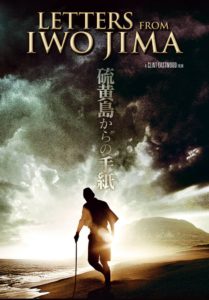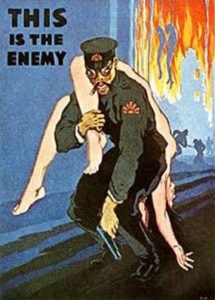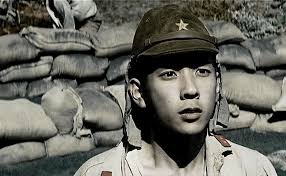Genre – War Movie (true story)
Time: 2 Hours, 20 minutes
Platform: Amazon Prime (on rent), You Tube (on rent)
Language: Japanese, English
Director : Clint Eastwood
 It’s a rare Hollywood / Western film that shows the enemy’s view of the same battle. There have been some examples in the past (and covered in earlier blogs) like Battle of Britain, Tora Tora Tora, A Bridge Too Far and a handful few (that will appear in future blogs). They showed what was happening on both sides of the battle, but within the same film and time frame.
It’s a rare Hollywood / Western film that shows the enemy’s view of the same battle. There have been some examples in the past (and covered in earlier blogs) like Battle of Britain, Tora Tora Tora, A Bridge Too Far and a handful few (that will appear in future blogs). They showed what was happening on both sides of the battle, but within the same film and time frame.
Letters from Iwo Jima stands out as a unique film, being the companion to Flags of Our Fathers, which was also released in 2006. While ‘Flags’ showed the Iwo Jima battle from the American perspective , from the point of view of the three surviving ‘flag raisers’ , ‘Letters’ does a similar job from the point of the ordinary Japanese soldiers and officers.
Throughout WW2, Japan and its soldiers were demonized by American propaganda, to where most American soldiers and sailors considered them non-human (see adjacent poster where an ape like ‘savage’ is carrying away a white woman). However, most American soldiers fighting in the Pacific developed a grudging respect for the ordinary Japanese soldier who fought with much less creature comforts than the Americans were used to. Due  to the Japanese view of surrender as shameful, and a “fighting to death” attitude, the Americans captured only a minimal number of prisoners in the Pacific (and the British and Australians in other regions). Death in battle was honorable and one’s duty. This, thus, led to the concept of the infamous ‘Kamikaze’ suicide planes that took a frightful toll on American ships in the Battle of Okinawa.
to the Japanese view of surrender as shameful, and a “fighting to death” attitude, the Americans captured only a minimal number of prisoners in the Pacific (and the British and Australians in other regions). Death in battle was honorable and one’s duty. This, thus, led to the concept of the infamous ‘Kamikaze’ suicide planes that took a frightful toll on American ships in the Battle of Okinawa.
These attitudes are masterfully portrayed by Clint Eastwood as he once again crafts a magnificent war film that reveals the human cost alongside the overall savagery and butchery. Though ‘Flags’ had actual characters, ‘Letters’ settles for a couple of composite fictional characters as ordinary soldiers, while keeping the other overall commanders, like Japanese Commander Lt Gen Tadamichi Kuribayashi and his aides, real.
 Thus, you have a bumbling ‘sad sack’ soldier Saigo (Kazunari Ninomiya) saved from punishment by Kuribayashi (Ken Watanabe), who gently admonishes Saigo’s superior that one soldier in punishment means one rifle less against the attacking Americans. Kuribayashi and Saigo keep bumping into each other one time or the other. Kuribayashi changes the overall defence strategy from fighting on the beaches to fighting in caves and tunnels which have been dug in the waiting period . Aware of the impending American assault, they prepare by stocking up and constructing many tunnels and caves. Saigo is joined by Private Shimizu (Ryo Kase) who is rumoured to be a Kempei Tai (Japanese Secret Police) officer who was demoted for some infraction back in Japan.
Thus, you have a bumbling ‘sad sack’ soldier Saigo (Kazunari Ninomiya) saved from punishment by Kuribayashi (Ken Watanabe), who gently admonishes Saigo’s superior that one soldier in punishment means one rifle less against the attacking Americans. Kuribayashi and Saigo keep bumping into each other one time or the other. Kuribayashi changes the overall defence strategy from fighting on the beaches to fighting in caves and tunnels which have been dug in the waiting period . Aware of the impending American assault, they prepare by stocking up and constructing many tunnels and caves. Saigo is joined by Private Shimizu (Ryo Kase) who is rumoured to be a Kempei Tai (Japanese Secret Police) officer who was demoted for some infraction back in Japan.
Soon the Americans attack.
We see the entire island battle develop from Saigo and Shimizu’s point of view. The desperate struggle to stay healthy in the dank and gloomy atmosphere of the caves. The lack of potable water and food. Disease. American shelling and bombing that take a frightful toll on them. The “no retreat’ order resulting in fanatical resistance to death. Saigo sees these and more.
The same battle scenes from ‘Flags’ are used here. Since the battle is shown from the Japanese point of view, the Americans are only seen as targets for machine guns and artillery guns. They are as faceless as the big guns from the battleships that are bombarding them and as faceless as the planes that relentlessly bomb them. These are the scenes that generate the same level of carnage and gruesome images as ‘Flags’. One of the most chilling scenes is the Japanese defenders committing suicide with grenades since they have been cut off and since no more ammunition is available. The level of gore is the same as in ‘Flag’ – so be warned.
The story from the Japanese side is pieced together by actual letters by Kuribayashi and post war survivor accounts. This is an absorbing companion to the same battle and with Eastwood at the helm, the proceedings are captivating.
The best thing about Eastwood’s direction is that the camera, and us, the audience, are like passive observers. We observe the horrors of war unfolding in front of us, be it Ira Hayes refusing to ‘climb that damn mountain’ or ‘Saigo’ struggling to stay alive while obeying Kuribayashi’s commands.
No big dialogues needed here. The interpretations are in our heads. War sucks. Big time.
Real History/ Historical Background – 5 out of 5
Script – 5 out of 5
Story – 5 out of 5
Direction – 5 out of 5
Photography – 5 out of 5
Total – 5 out of 5
Thank you for another excellent review, Rammesh.
Not much more for me to add to your analysis, except a quote from Richard Schickel’s “Clint, A Retrospective”: (published in 2010)
“Austere yet gracefully portrayed by Ken Watanabe, Kuribayashi emerges as one of the great Eastwoodian heroes, a man doing his duty, knowing that he must die in so doing and accepting that fact without the slightest hint of self-pity.
I have in this book identified Clint as, most significantly, a dutiful man, so there is perhaps an irony in the fact that this most American of directors would find the avatar of his virtue that most significantly defines him in a man formed by traditions entirely opposite of those that formed Clint.
There is perhaps a further irony in the fact that it was Letters from Iwo Jima, not the much grander Flags of Our Fathers, that dominated the Ten Best lists and contended for the significant awards in the winter of 2006.”
————–
Some trivia:
With his sense of decorum, Eastwood released the film in Tokyo, on December 9, 2006 and a few weeks later in the U.S. (Wiki)
“Most of the young cast knew nothing about the incidents on Iwo Jima, as it is not taught in Japanese schools.” (IMDb)
Eastwood’s thoughts:
“Every movie I make teaches me something, and that’s why I keep making them. I’m at that stage of life when I could probably stop and just hit golf balls. But in filming these two movies about Iwo Jima, I learned about war and about character. I also learned a lot about myself”.
(He is not ready to hit golf balls just yet – at age 93, he is currently filming his next movie, ‘Juror No. 2’)
Thanks a lot for adding those additional comments; I learned something. My viewing of the odd Japanese war films confirms to me they are usually formulaic jingoistic stuff about men doing their duty and screaming Banzai all the time.So too with the usual Hollywood output. Tora Tora Tora changed it to some extent with nuanced characterisation but there is nothing much about inner turmoils and knowing that doing their duty = sure death.
One imdb comment goes so far to say that this is the movie the Japanese should have made. Cant be a better tribute to Eastwood’s talent.
KVR
Amazing review and understanding the layers of emotions. Took me right there, great Rammesh, keep sending out.